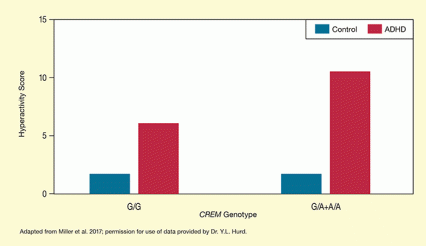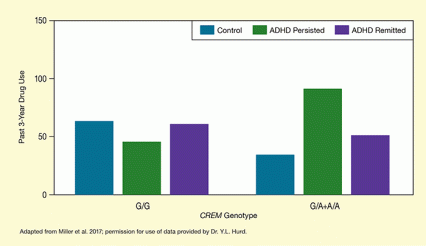This research:
- Identified a gene variant that promotes impulsive behavior and enhanced responses to heroin in rats.
- Linked the corresponding human gene variant to increased risk for impulsivity and drug use.
People who are highly impulsive and those diagnosed with ADHD are at increased risk for substance use disorders (SUD). Recent research implicates a variant of the gene for a protein called cAMP-response element modulator (CREM) in these associations. Drs. Michael L. Miller and Yasmin L. Hurd from the Icahn School of Medicine at Mount Sinai in New York, with colleagues from several other institutions, showed that the gene variant promotes impulsive and hyperactive behavior in both animals and humans, and can contribute to a person’s risk for developing SUD.
Of Rats…
The Icahn researchers began their investigations with a strain of rats that exhibit impulsive behaviors resembling human attention-deficit/hyperactivity disorder (ADHD). Initial experiments confirmed that, compared with a strain (Western Kyoto) of rats that are not known for impulsivity, these "spontaneously hypertensive" (SH) rats:
- Were more impatient to receive rewards, fidgeted more while waiting to receive rewards, ran around more, and were more attracted to novel experiences.
- Self-administered more heroin and, when it was made unavailable, gave up seeking it less readily.
- Had enhanced elevation of dopamine levels in response to heroin.
The researchers screened the rats’ DNA for genetic differences that might contribute to these behavioral differences. The results revealed that the two strains carried different variants of the gene for CREM. As a result, the SH rats had lower concentrations of CREM in the core of the nucleus accumbens—a key brain region governing reward and movement.
…And People
The researchers used genetic and behavioral evidence from previous studies conducted by other researchers to demonstrate that the corresponding variant in the human CREM gene similarly predisposes people to impulsivity. This variant occupies approximately the same position on the human gene that the rodent variant occupies on the rodent gene. At this site, known as rs12765063, the CREM gene exists in two versions—called A and G—and the A variant dials down CREM production. In one study, preschool children with the A variant were found to be more distractible and to engage in more dangerous activities than peers with only the G variant (Figure 1). In another, among adolescents with ADHD, those who carried the A variant reported more symptomatic hyperactivity than those who did not.
The researchers further found that by promoting impulsivity, the variant raises the risk of drug use. Thus, in two studies of adolescents, neither the A variant alone nor ADHD alone increased the risk for drug use, but the two together did. The first analysis looked at adolescents with ADHD, and found higher rates of drug use among those with the A variant than among those with only the G variant. The second analysis looked at adolescents who had the A variant of rs12765063 and histories of childhood ADHD. It found that those whose childhood ADHD still persisted reported more use of alcohol, tobacco, marijuana, and prescription stimulants than those who had outgrown their ADHD (Figure 2). Moreover, those who no longer had ADHD reported no more drug use than a comparison group who did not carry the A variant.
A Key to Prevention and Treatment?
Dr. Hurd suggests that CREM may be a key link between impulsivity and vulnerability to addiction. Understanding these relationships may help identify new ways of treating or preventing SUD. The protein is known to regulate multiple gene networks and their biological functions, and to influence the growth of structures that neurons use to communicate with each other.
Dr. Hurd says, "These results highlight that CREM is a mediating factor between impulsivity and substance abuse vulnerability. It brings attention to CREM in the nucleus accumbens as a regulator of impulsive action and structural plasticity."
The study was supported by NIH grants DA015446, DA030359, DA006470, DA038954, DA031559, and DA007135.
- Text Description of Figure 1
-
The bar chart shows the hyperactivity scores of people with and without ADHD with different CREM gene variants. Red bars represent people with ADHD and blue bars represent people without ADHD. The horizontal x-axis shows the two sets of gene variants that were compared, with the two bars on the left representing people carrying only the G variant (i.e., a G/G genotype) and the two bars on the right representing people carrying at least one copy of the A variant (i.e., G/A and A/A genotypes). The vertical y-axis shows the hyperactivity score on a scale from 0 to 15. For people without ADHD, the hyperactivity score was approximately 1.5 for both those with the G/G genotype and those with the G/A or A/A genotype. For people with ADHD, the hyperactivity score was approximately 6 for those with the G/G genotype and approximately 12 for those with the G/A or A/A genotype.
- Text Description of Figure 2
-
The bar chart shows the past 3-year drug use for people with persistent or remitted ADHD and people without ADHD with different CREM gene variants. Blue bars represent people without ADHD; green bars represent people with persistent ADHD (i.e., symptoms lasting beyond age 18), and purple bars represent people with remitted ADHD. The horizontal x-axis shows the two sets of gene variants that were compared, with the three bars on the left representing people carrying only the G variant (i.e., a G/G genotype) and the three bars on the right representing people carrying at least one copy of the A variant (i.e., G/A and A/A genotypes). The vertical y-axis shows past 3-year drug use on a scale from 0 to 150. For people without ADHD, past 3-year drug use was approximately 60 for those with the G/G genotype and approximately 30 for those with the G/A or A/A genotype. For people with persistent ADHD, past 3-year drug use was approximately 40 for those with the G/G genotype and approximately 90 for those with the G/A or A/A genotype. For people with remitted ADHD, past 3-year drug use was approximately 60 for those with the G/G genotype and approximately 50 for those with the G/A or A/A genotype.
Source:
- Miller, M.L., Ren, Y., Szutorisz, H., et al. Ventral striatal regulation of CREM mediates impulsive action and drug addiction vulnerability. Mol Psychiatry 23(5):1328-1335, 2018. Published online 2017 Apr 25. doi: 10.1038/mp.2017.80


